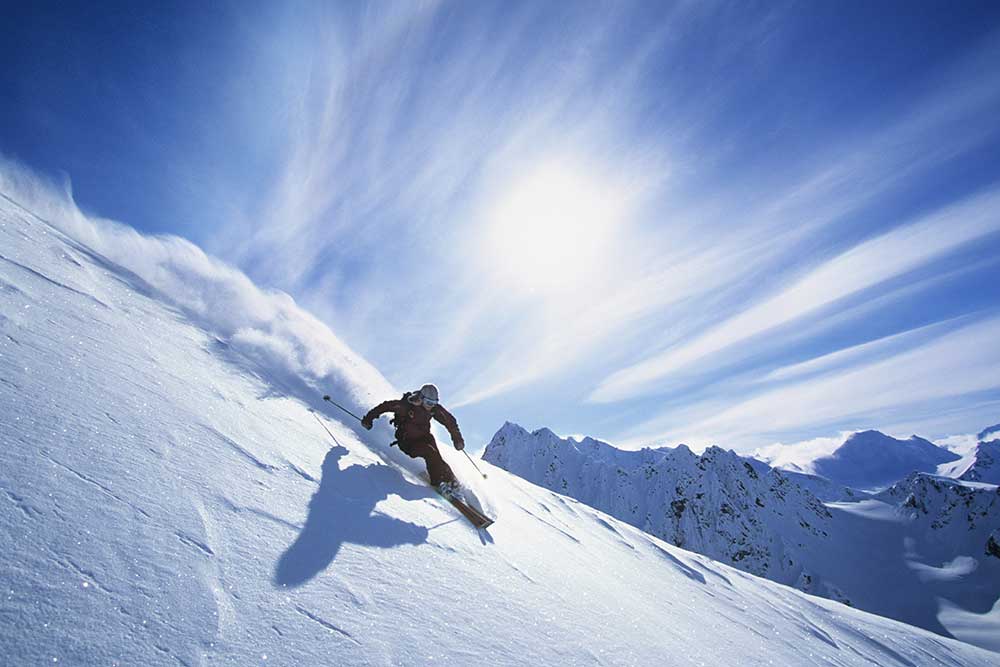
The 2022 ski season is in full swing. Most ski enthusiasts understand that preparation and heads-up precautions are the remedies for preventing ski accidents. Shoulder injuries make up a moderate percentage of total ski injuries, and they require comprehensive rehabilitation to return to skiing. Richard Cunningham, MD, a shoulder, knee and medicine sports specialist, offers injured skiers the immediate care required to expedite a return to skiing.
Common shoulder ski injuries
Common shoulder injuries that occur when skiing are often due to an impact event. Whether a fall or collision, a sudden force to the upper body can result in a shoulder injury. Types of shoulder injuries include:
- Fracture of one or more shoulder complex bones – There are three major and two minor bones of the shoulder. The clavicle, or collarbone, is most frequently subject to fracture, usually when an outstretched hand is used to break a skier’s fall. Less frequently, the humerus, or upper arm bone, and its rotator cuff attachment sites called the greater tuberosity, and the scapula, or shoulder blade, are all subject to fracture. These injuries limit motion and strength, and radiate pain through the shoulder into the arm, typically halting activity causing one to seek medical attention.
- Dislocation of shoulder joints – The acromioclavicular (AC) joint on the top of the shoulder has the least degree of depth of all the joints of the body. As such, it can easily separate or dislocate, especially in an impact event in skiing. Most frequently, the impact forces the shoulder blade downward, dislocating the clavicle upward such that the end of the collarbone is visibly prominent. This separation is typically very painful, requiring medical attention. Another common dislocation involves the glenohumeral joint, where the humeral head is forced out of the socket or glenoid. Most patients who suffer these dislocations experience severe pain and seek immediate medical attention in order to have the shoulder joint reduced or put back in place. Dr. Cunningham has the expertise and experience to treat shoulder dislocations, and return skiers to the slopes.
- Injury to shoulder soft tissue – Critical to the wide range of movement of the shoulder are all of the soft tissues. Ligaments, tendons, bursae, labrum, and muscle supply the function, range of motion, and strength to the shoulder. Injury from an impact can result in damage to one or more of these structures. For instance, as a result of a hard fall one might tear their rotator cuff tendons. A skier’s overuse of the shoulder can set one up for impingement of the rotator cuff, or a rupture of the biceps tendon. Soft tissue injuries may require surgical repair for the alleviation of pain and restoration of strength and function. Dr. Cunningham can diagnose and prescribe the best course of treatment to allow for a full return of shoulder health.
What to expect from shoulder injury treatment
Treatment protocols will be individualized to each patient, but the general progression is as follows:
For less acute injuries, begin with a course of conservative home care. This will involve –
- Avoiding those activities that worsen the pain
- Icing the site of injury
- Pain management via NSAIDs or acetaminophen as needed
- Commitment to physical therapy if indicated
If symptoms do not improve or they worsen, or in the case of a more severe injury involving damage to the soft tissue, joints or bone, it is best too:
- Access orthopedic care by a shoulder specialist as soon as possible
- Be prepared to describe how you were injured
- Undergo any required diagnostic tests (ie. xray, MRI)
- Undergo a physical exam, receive an accurate diagnosis and recommended treatment plan
- When surgery is required, prepare to dedicate yourself to the rehabilitation process
- Attend follow up orthopedic appointments to ensure you are on track
- Be patient with the process
- Avoid reinjury by returning to skiing or other shoulder intensive activities too soon
The time required to return to skiing or snowboarding following a shoulder injury will be individualized. Dr. Cunningham, and his expert shoulder care team will guide patients back to the slopes as early as is warranted.
Optimize the Return to Skiing
In order to obtain a good outcome after treatment, physical therapy is critical. Dr. Cunningham is pleased to work with a number of highly accomplished and experienced physical therapists. Along with the physical therapist, you will receive an individualized rehabilitation protocol as well as regular follow up visits with Dr. Cunningham to be sure you are achieving all the important milestones at the appropriate time. Here are some of the components of a good rehab program:
- Individually defined criterion to allowed a gradual return to various activities
- Regular assessments to be sure you are achieving certain milestones and your ultimate goals
- Functional upper extremity testing to monitor progress
- Balanced progression of micro and macro shoulder restoration
- Maintaining patient motivation via discrete improvement feedback
- Minimizing fear of reinjury and performance apprehension
Use of a shoulder and sports medicine specialist like Dr. Richard Cunningham and his experienced care team can be your best option for a return to the prior level of performance and satisfaction on the slopes, with the greatest possible preparation to avoid reinjury to the shoulder. Contact Dr. Cunningham at 970-476-7220.
